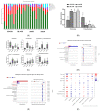Barley Leaf Ameliorates Citrobacter rodentium-Induced Colitis through Preventive Effects
- PMID: 36145206
- PMCID: PMC9502111
- DOI: 10.3390/nu14183833
Barley Leaf Ameliorates Citrobacter rodentium-Induced Colitis through Preventive Effects
Abstract
The incidence and prevalence of inflammatory bowel disease (IBD) have been increasing globally and progressively in recent decades. Barley leaf (BL) is a nutritional supplement that is shown to have health-promoting effects on intestinal homeostasis. Our previous study demonstrated that BL could significantly attenuate Citrobacter rodentium (CR)-induced colitis, but whether it exerts a prophylactic or therapeutic effect remains elusive. In this study, we supplemented BL before or during CR infestation to investigate which way BL acts. The results showed that BL supplementation prior to infection significantly reduced the disease activity index (DAI) score, weight loss, colon shortening, colonic wall swelling, and transmissible murine colonic hyperplasia. It significantly reduced the amount of CR in the feces and also markedly inhibited the extraintestinal transmission of CR. Meanwhile, it significantly reduced the levels and expression of tumor necrosis factor-alpha (TNF-α), interferon-gamma (IFNγ), and interleukin-1β (IL1β). In addition, pretreatment with BL improved CR-induced gut microbiota dysbiosis by reducing the content of Proteobacteria, while increasing the content of Lactobacillus. In contrast, the effect of BL supplementation during infestation on the improvement of CR-induced colitis was not as good as that of pretreatment with BL. In conclusion, BL protects against CR-caused colitis in a preventive manner.
Keywords: Citrobacter rodentium; barley leaf; colitis; gut microbiota; prophylactic effect.
Conflict of interest statement
The authors declare no conflict of interest.
Figures











Similar articles
-
Barley Leaf Ameliorates Citrobacter-rodentium-Induced Colitis through Arginine Enrichment.Nutrients. 2023 Apr 14;15(8):1890. doi: 10.3390/nu15081890. Nutrients. 2023. PMID: 37111109 Free PMC article.
-
Lactobacillus plantarum-derived extracellular vesicles from dietary barley leaf supplementation attenuate Citrobacter rodentium infection and intestinal inflammation.J Nanobiotechnology. 2025 Jun 7;23(1):426. doi: 10.1186/s12951-025-03504-w. J Nanobiotechnology. 2025. PMID: 40481571 Free PMC article.
-
Probiotics are effective for the prevention and treatment of Citrobacter rodentium-induced colitis in mice.J Infect Dis. 2012 Jul 1;206(1):99-109. doi: 10.1093/infdis/jis177. Epub 2012 Mar 19. J Infect Dis. 2012. PMID: 22430833
-
Colonic levels of vasoactive intestinal peptide decrease during infection and exogenous VIP protects epithelial mitochondria against the negative effects of IFNγ and TNFα induced during Citrobacter rodentium infection.PLoS One. 2018 Sep 25;13(9):e0204567. doi: 10.1371/journal.pone.0204567. eCollection 2018. PLoS One. 2018. PMID: 30252907 Free PMC article.
-
The Probiotic Lactobacillus Prevents Citrobacter rodentium-Induced Murine Colitis in a TLR2-Dependent Manner.J Microbiol Biotechnol. 2016 Jul 28;26(7):1333-40. doi: 10.4014/jmb.1602.02004. J Microbiol Biotechnol. 2016. PMID: 27056471
Cited by
-
Barley a nutritional powerhouse for gut health and chronic disease defense.Heliyon. 2024 Sep 28;10(20):e38669. doi: 10.1016/j.heliyon.2024.e38669. eCollection 2024 Oct 30. Heliyon. 2024. Retraction in: Heliyon. 2025 Mar 14;11(6):e43088. doi: 10.1016/j.heliyon.2025.e43088. PMID: 39640645 Free PMC article. Retracted. Review.
-
Ginkgo biloba Extract Preventively Intervenes in Citrobacter Rodentium-Induced Colitis in Mice.Nutrients. 2023 Apr 21;15(8):2008. doi: 10.3390/nu15082008. Nutrients. 2023. PMID: 37111225 Free PMC article.
-
Dextran sodium sulfate-induced colitis alters the proportion and composition of replicating gut bacteria.mSphere. 2025 Jan 28;10(1):e0082524. doi: 10.1128/msphere.00825-24. Epub 2024 Dec 26. mSphere. 2025. PMID: 39723822 Free PMC article.
-
Barley Leaf Ameliorates Citrobacter-rodentium-Induced Colitis through Arginine Enrichment.Nutrients. 2023 Apr 14;15(8):1890. doi: 10.3390/nu15081890. Nutrients. 2023. PMID: 37111109 Free PMC article.
-
Application of network pharmacology in traditional Chinese medicine for the treatment of digestive system diseases.Front Pharmacol. 2024 Jul 17;15:1412997. doi: 10.3389/fphar.2024.1412997. eCollection 2024. Front Pharmacol. 2024. PMID: 39086391 Free PMC article. Review.
References
-
- Kotze P.G., Underwood F.E., Damião A.O.M.C., Ferraz J.G.P., Saad-Hossne R., Toro M., Iade B., Bosques-Padilla F., Teixeira F.V., Juliao-Banos F., et al. Progression of Inflammatory Bowel Diseases Throughout Latin America and the Caribbean: A Systematic Review. Clin. Gastroenterol. Hepatol. 2020;18:304–312. doi: 10.1016/j.cgh.2019.06.030. - DOI - PubMed
MeSH terms
Substances
Grants and funding
LinkOut - more resources
Full Text Sources

